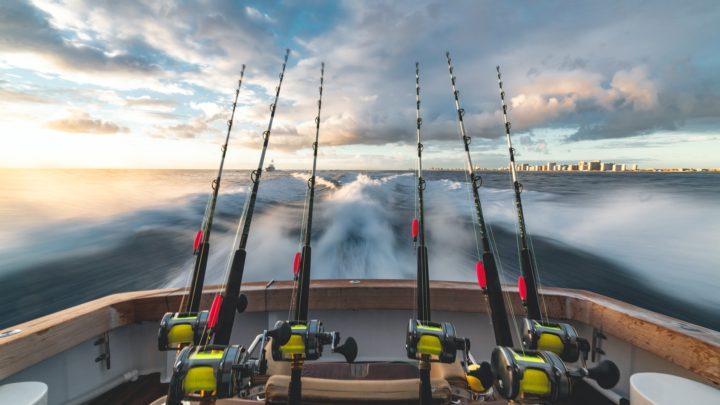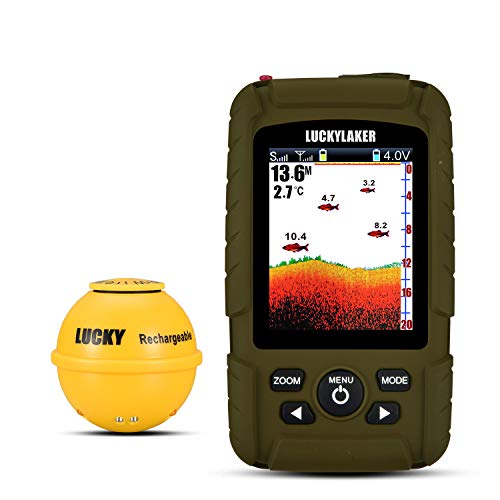Thanks to the latest technology, fishing is now much easier with fish finder devices navigating you to your next catch.
Now, with the growing number of options, you may not be sure which is the best fish finder for a bass boat. Luckily, we’ve narrowed it down to a few of our top picks to get you started.
Stick around to learn more about the best fish finder for your bass boat.
Top Fish Finders for Bass Boat
Whether you’re trying to get a reading of where the fish’s hiding spots are or getting an indicator of the water’s depth, fish finders are the tool to use. Check out our top fish finders for bass boats below.
1. Humminbird Helix 5
Humminbird is a well-known brand in the fish finder industry. With a 5-inch colored screen, the Humminbird Helix 5 model features a dual beam plus sonar. This allows you to gain enhanced details on your screen and provides lots of coverage.
With this technology, you can use the wide or narrow beam side-by-side, separately, or blended together. Another feature worth considering in the Humminbird model is the SwitchFire Sonar. With it, you get to customize how sonar feedback is displayed.
For instance, you can remove or add information such as temperature, water depth, and turbulence. You can also choose to view lure presentations. To do this, you just need to use the keypad control.
When it comes to the transducer, this Humminbird model comes with one that transmits dual spectrum CHIRP 2D sonar. CHIRP technology basically controls the pulses sent by the transducer, mostly through frequency changes. Speaking of which, the transducer included has a frequency ranging between 150 to 220kHz.
Pros
- Includes a keypad
- The transducer has CHIRP technology
- Comes with SwitchFire Sonar technology
Cons
- Doesn’t include GPS
2. LUCKY Portable Fish Finder
This LUCKY fish finder model is one of the best portable options for your bass boat. This fish finder’s transducer is castable. In terms of screen resolution, the LUCKY fish finder isn’t our first pick since the screen is small, but it does infuse three distinct color modes to provide a decent display.
In some cases, the LUCKY fish finder can distinguish between small, medium, and large fish. Having said that, its signal frequency can reach about 125kHz at a 90-degree angle, which may give an adequate reading. In addition to this, the LUCKY fish finder has a built-in fish alarm to inform you of nearby fish.
Pros
- Includes fish alarm
- Portable
- Budget-friendly
Cons
- Mostly contains basic features
3. Garmin ECHOMAP
If you’re looking for a professional-grade fish finder, then you may want to consider the Garmin ECHOMAP. This seven-inch displayed fish finder comes with a premium screen resolution that can show on the sunniest of days.
This fish finder will give you an optimal navigation system with Navionics data. You also get the Worldwide Basemap feature that covers oceans, rivers, lakes, and streams.
For even more detailed imaging the Garmin ECHOMAP has US Lakevu G3 and Bluechart G3 features. The latter gives you a view of coastal fishing regions, canals, and oceans.
Pros
- Integrated with highly detailed mapping features
- Optimal screen resolution
- Contains quick-release mounting
Cons
- Can to be too complicated for beginners to use
Buyer’s Guide
When purchasing a fish finder for your bass boat, there are a lot of features worth considering. Here are some of them below.
Display
The display encompasses the fish finder’s screen resolution, screen size, and whether it’s black and white or colored. Now, when considering the screen resolution, you wouldn’t want to be staring at a highly pixelated image trying to figure out what it says.
Instead, a 240 x 160-pixel resolution should have you covered. Nevertheless, if you have the option of higher pixeled imaging, then we highly recommend it, because you won’t have to strain your eyes too much.
Apart from that, the screen size should preferably be large enough for you to spot your next catch. Now, between colored and black or white screens, the latter may not give you the most accurate reading, plus with sunlight, it’ll be harder to see. Meanwhile, colored screens give you better information and indicators of the fish’s location.
Transducer
The transducer is the main component of your fish finder. It controls the sonar signals coming out of the device. Once the signals bounce back from an object underwater, the transducer is able to pick them back up.
The central unit in the transducer processes the feedback and displays the readings. You typically want a high-performing transducer to get the most accurate image.
Transducer Mounting
Besides that, the transducer mounting device material is also crucial since you want a durable option that can withstand the rough and tumble of the water. Plastic material is practically universal to all boats and a good option for hobbyists.
The mounting of the transducer is usually at the back, where the trolling motor is located. It’s called a transom mount transducer. This is the area with the least water exposure.
Another option is the through-hull mounts, which are affixed to the side of the boat. This type of mount is generally on the pricier end since it’s the toughest and most flexible.
Cone Angles
The cone angle is the amount of surface the fish finder covers when sending sonar signals. It’s usually referred to as the width of the signal, so the wider it becomes, the bigger the coverage.
Nevertheless, wider doesn’t necessarily mean better since some finders have large cone angles but weaker wave delivery.
Power
The power of the fish finder, measured in watts, will determine how strong your sound wave signal is. It’ll then decide how far your device can reach. Fish finder power usually ranges depending on the size of the device. It can generally go between 100 to 1000 watts, with the latter mainly used for deep sea excursions.
The power can also determine how detailed of an image you’ll be getting. In most cases, a 500-watt fish finder should give you an ideal image, whereas 200 to 300-watt options are best used for shallow waters.
As a general rule of thumb, every 100 watts equates to an extra 400 feet of depth imaging with a 50 kHz frequency.
Frequency
Similar to power, your fish finder’s frequency, which is measured in Hertz, also plays a role in the quality and depth of the image you get. Both power and frequency work synergistically to craft your display.
Unlike with power, frequency works differently, where the more you have of it, the less power and depth you get. That’s because lower frequencies have better chances of penetrating water. Having said that, you’ll want to find a fish finder with around 50 kHz or so.
To Conclude
With the plethora of choices available, it may be tough to find the best fish finder for your bass boat. That being so, it all comes down to features such as power, transducer quality, frequency, and display resolution.
With those characteristics in mind, you’ll be able to find a suitable option to use on your next fishing trip.




